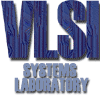
|
|
Real time distortion correction in wide angle camera imagesImages captured with a typical wide-angle camera
lenses show spatial distortion, which necessitates spatial warping for subsequent
analysis. In this research, an efficient architecture for an embedded system
for the real-time correction of barrel distortion in wide-angle camera images
is proposed. The spatial warping procedure follows a methodology based on
least-squares estimation to correct the non-linear distortion in the images.
A mathematical model of polynomial mapping is used to map the images from
distorted image space onto the warped image space. The model parameters include
the expansion polynomial coefficients, distortion centre and corrected centre.
The spatial warping model is applied to several gastrointestinal images.
A very high speed pipelined architecture for the real-time correction of
barrel distortion in wide-angle camera images is being developed in the VLSI
Systems Laboratory. The CORDIC based hardware design is suitable for an 8-bit
input image of size up to 2056x2056 pixels and is pipelined to operate at
a clock frequency of 33 MHz and it produces the corrected image at a rate
of 30 frames per second. The VLSI system will facilitate the use of a dedicated
hardware that could be mounted along with the camera unit.
References [1] H. Kato and J. P. Barron, Electronic Videoendoscopy, Switzerland: Harwood Academic Publishers, 1993. [2] A. Sonnenberg, M. Giger, L. Kern, C. Noll, K. Stuby, K. B. Weber, and A. L. Blum, “How Reliable is Determination of Ulcer Size by Endoscopy,” Brit. Med. J., vol. 24, 1979, pp. 1322-1324. [3] C. Margulies, B. Krevsky, and M. F. Catalano, “How Accurate are Endoscopic Estimates of Size,” Gastrointestinal Endoscopy, vol. 40, 1994, pp. 174-177. [4] R. Y. Tsai, “An Efficient and Accurate Camera Calibration Technique for 3D Machine Vision,” Proc. IEEE Comput. Vision Patt. Recogn, Miami, FL, 1986, pp. 364-374. [5] D. C. Brown, “Decentreing Distortion of Lenses, ” Photogramm. Eng. Remote Sensing, 1966, pp. 444-462. [6] Y. Nomura, M. Sagara, H. Naruse, and A. Ide, “Simple Calibration Algorithm for High-Distortion-Lens Camera,” IEEE Trans. Patt. Anal. Machine Intell, vol. 14, no. 11, 1992, pp. 1095-1099. [7] J. Weng, P. Cohen, and M. Herniou, “Camera Calibration with Distortion Models and Accuracy Evaluation,” IEEE Trans. Patt. Anal. Machine Intell., vol. 14, no. 10, 1992, pp. 965-980. [8] W. E. Smith, N. Vakil, and S. A. Maislin, “Correction of Distortion in Endoscopic Images,” IEEE Trans. Med. Imaging, vol. 11, no. 1, 1992, pp. 117-122. [9] H. Hideaki, Y. Yagihashi and Y. Miyake, “A New Method for Distortion Correction of Electronic Endoscope Images,” IEEE Trans. Med. Imaging, vol. 14, no. 3, 1995, pp. 548-555. [10] K. V. Asari, S. Kumar, and D. Radhakrishnan, “A New Approach for Non-linear Distortion Correction in Endoscopic Images based on Least Squares Estimation,” IEEE Trans. Med. Imaging, vol. 18, no. 4, 1999, pp. 345-354. [11] J. P. Helferty, C. Zhang, G. McLennan, and W. E. Higgins, “Videoendoscopic Distortion Correction and Its Application to Virtual Guidance of Endoscopy,” IEEE Trans. Med. Imaging, vol. 20, no. 7, July 2001, pp. 605-617. [12] S. D. Haynes, J. Stone, P. Y.K. Cheung, and W. Luk, “Video Image Processing with Sonic Architecture,” IEEE Computer, April 2000. pp. 50-57. [13] D. Pearson, Image Processing, United Kingdom: McGraw-Hill Book Company, 1991. [14] S. Y. Kung, VLSI Array Processors, Englewood Cliffs, NJ: Prentice Hall, 1998. [15] K. Vijayan Asari, “Non-linear Spatial Warping of Endoscopic Images: An Architectural Perspective for Real-Time Applications,” Journal of Microprocessors and Microsystems, vol. 26, no. 4, May 2002, pp.161-171. [16] M. J. Flynn, Computer Architecture: Pipelined and Parallel Processor Design, United States: Johns and Bartlett Publishers, Inc., 1995. [17] S. G. Shiva, Pipelined and Parallel Computer Architectures, United States: HapperCollins Publishers, Inc., 1996. [18] J. D. Bruguera, N. Guil, T. Lang, J. Villalba and E. L. Zapata, “CORDIC Based Parallel/Pipelined Architecture for the Hough Transform,” Journal of VLSI Signal Processing, January 2001. [19] Advanced Micro Devices, Inc., “White Paper for QuantiSpeed Architecture,” September 2001. [20] H. Ngo, K. V. Asari, “Design of an Efficient VLSI Architecture for Real-Time Correction of Barrel Distortion in Wide-Angle Camera Images,” 10th NASA Symp. on VLSI Design, Albuquerque NM, Mar. 2002, 8.5.1-8.5.7. [21] D. A. Berry and B. W. Lindgren, Statistic: Theory and Methods. CA: Brooks/Cole, 1990. [22] J. Volder, “The CORDIC Trigonometric Computing Technique,” IRE Trans. Electronic Computing, vol. EC-8, 1959, pp. 330-334. [23] R. Andraka, “A survey of CORDIC algorithm for FPGAs,” in Proc. ACM/SIGDA 98, Feb. 1998, pp. 191-20. |

|
VLSI Systems Laboratory
|

|